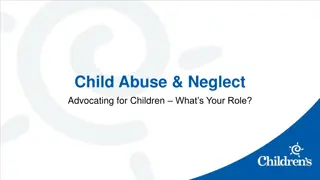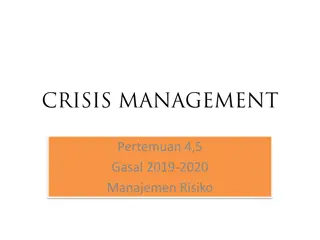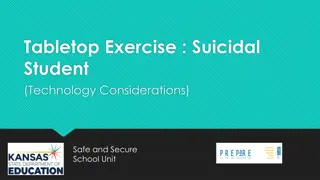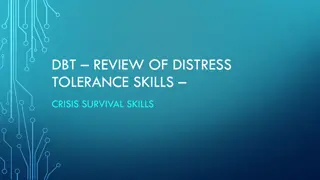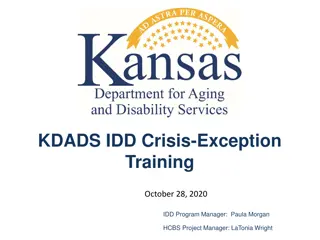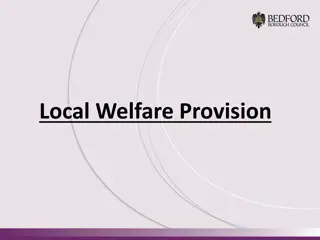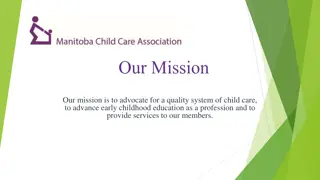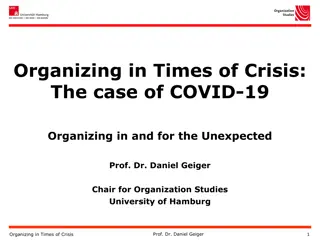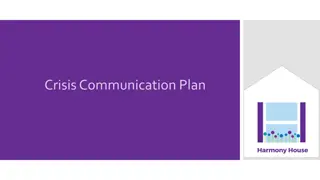ADVOCATING FOR CRISIS CARE
"Explore the journey of NAMI Santa Cruz County in advocating for crisis care, uncovering concerns, strategies, and decisions made to drive change in mental health services."
Download Presentation

Please find below an Image/Link to download the presentation.
The content on the website is provided AS IS for your information and personal use only. It may not be sold, licensed, or shared on other websites without obtaining consent from the author.If you encounter any issues during the download, it is possible that the publisher has removed the file from their server.
You are allowed to download the files provided on this website for personal or commercial use, subject to the condition that they are used lawfully. All files are the property of their respective owners.
The content on the website is provided AS IS for your information and personal use only. It may not be sold, licensed, or shared on other websites without obtaining consent from the author.
E N D
Presentation Transcript
ADVOCATING FOR CRISIS CARE NAMI California Conference 2018 Carol Williamson, President, NAMI Santa Cruz County Michael Fitzgerald, Zayante Group
Why Advocate? It can work it did for us Feedback is needed Our voice matters If not NAMI, then who?
Background Closure of 28-bed psychiatric unit by Dominican Hospital in 2014 County built new smaller 16-bed Psychiatric Hospital with small Crisis Stabilization Program Operation of facility was contracted out to a for-profit company NAMI s work was inspired by two tragic fatalities in two years
What were the concerns? 1 of 2 Complaints, rumors, tragedies, calls, and written stories Releases without adequate stabilization No psychiatrist involved in decision to release Difficult admittance from Crisis Stabilization Program (CSP) into Psychiatric Health Facility Assessments done by unlicensed staff, and without consideration of family input Families given inadequate information and support, rude, brusque treatment during crisis
What were the concerns (2 of 2) Many clients sent far away out of county Inadequate food in CSP Inadequate space and comfort Staffing vacancies and inadequate training Releases without adequate follow up care Revolving door Law enforcement concerns County responses to NAMI concerns were insufficient
Strategy and Decisions Create an investigative task force include local experts with system experience, Board members Document problems, collect stories, and write a report Engage a technical advisor
Educating the Task Force The role of the Technical Advisor to Educate Task Force: Regulations, regulators Standards of care, rights of clients and families Best practices Questions to ask, who to ask Understand funding and regulatory standards Strategies to promote change Clarify obscure or complex responses from providers
Process Page 1 of 3 Many meetings Developed a list of improvement requests. Sent strong letter to top leadership of contractor. Contractor responsive and stated strong commitment to improvements
Process Page 2 of 3 Top leaders of Contractor met with NAMI, County Mental Health included Contractor developed document for tracking implementation plans/progress Frequent progress meetings Deadline set for final agreements
Process 3 of 3 Investigative report published Met with City Council members Met with members of Board of Supervisors Local paper headline: NAMI Report Sparks Improvements
Outcomes 1 of 2 New Management Better staffing ratios, better pay Psychiatrist must approve releases 5150 Staff receive more training, including NAMI Provider Education, Columbia Suicide Risk Assessment Shower added to CSP. Food improved Assessments done by qualified staff
Outcomes 2 of 2 The Family Information Form is now widely used Lab work to be done at CSP without transport of client to hospital County connects clients to other services County agreed to re-write 5150 Training manual with input from NAMI Continue ongoing meetings
Lessons Learned and Tough Questions 1 of 2 Engage the highest levels of management, they may not know the extent of problems. Open communication with NAMI, County and contractor is important Assessments of 5150 are variable, within County and within state. Misunderstanding of privacy rights causes great difficulties
Lessons Learned and Tough Questions 2 of 2 Shortage of beds: The Federal IMD exclusion causes 16 bed psychiatric health facilities unless part of a hospital There are strong financial incentives to not hospitalize It s complicated Technical expertise was and is essential
Our roles as Advocates Important responsibility. Relationships matter. Difficult road, emotional Does funding affect your advocacy role? Engage the media effectively Embrace allies and the caring community. Smaller everyday advocacy also important Prioritize advocacy efforts If not NAMI, then who?
Tips for Advocating Set a Goal Narrow it Down Specific, Measurable, Actionable, Realistic, Time-Bound Define your message Build a team Map out your timeline Develop your communications and activities
Questions? Links namiscc.org/advocacy: CA Conference slide presentation NAMI Santa Cruz County Investigative Report on Crisis Care NAMI CAN: NAMI California Advocacy: namicaadvocacy.org Online advocacy software app: SalsaLabs.com NAMI Santa Cruz Carol Williamson: cwilliamson@namiscc.org, 831.824.0406 Technical Advisor Michael Fitzgerald mfitzgerald@zayantegroup.org 650.988.7792
Appendix: Report Recommendations namiscc_task_force_report_on_crisis_care.pdf Page 1 of 5 1.The County of Santa Cruz and the Contractor Administration should support the newly hired, experienced leadership at the CSP with the resources that they determine necessary for the improvement of care, including staffing allocations. 2. Recommend further advanced training for the mental health professionals designated for the evaluation of involuntary detainment, including training in suicide risk assessment. Recommend that an experienced licensed (rather than waived ) professional to consistently perform the intake crisis assessment. 3. Ensure staff evaluating the patient reviews the 5150/5585 form to determine if police are requesting notification for potential charges, prior to the patient being released.
Appendix: Report Recommendations 2 of 5 4.The county to engage NAMI as a key stakeholder in updating the LPS/5150 training manual for the application and evaluation for involuntary detainment and explore options for those not meeting criteria for a 5150 hold. 5. Standardize best practice to improve staff interactions with families and patients. Consistently use the AB1424 Family Information Form as indicated in state law. Prioritize continued education on family engagement with staff and active feedback from NAMI. 6. Provide to family, as approved by the patient, an aftercare plan inclusive of medication information, follow-up services at the time of release, and educational materials applicable to the diagnosis.
Appendix: Report Recommendations 3 of 5 7. Provide, with patient consent, information to the family regarding the decision about the level of care, and document such in the medical record. 8. County to provide CSP patients with face-to-face or telephone introduction when possible for follow-up county services recommended on discharge. 9. Recommend a change in accreditation vendor in the CSP from CARF to the Joint Commission.
Appendix: Report Recommendations Page 4 of 5 10. County should explore increasing crisis residential resources and other 24 hour transitional residential treatment similar to Telos, (only 10 beds) with strong staffing support, to decrease discharges to unstable living situations or homelessness. 11. Working with CSPs across California, with input from consumers and families, identify and implement best-practice standards. 12. Implement changes in the medical clearance process and lab testing process to avoid unnecessary and redundant trips to the Emergency Department.
Appendix: Report Recommendations 5 of 5 13. Evaluate capacity of the CSP to be determined along with a diversion plan or extra capacity that ensures the patient safety and improved service model. 14. Continue efforts to reduce staff turnover in the CSP and PHF, through improvement in wage scales, training, and improvement in the culture of care. 15. Empower nursing and social work/therapists through competitive wage scales, autonomy / leadership opportunity. Encourage and reimburse for specialty certifications. 16. Foster leadership stability and engagement and inclusion of key Telecare staff in system of care discussions with Santa Cruz County.
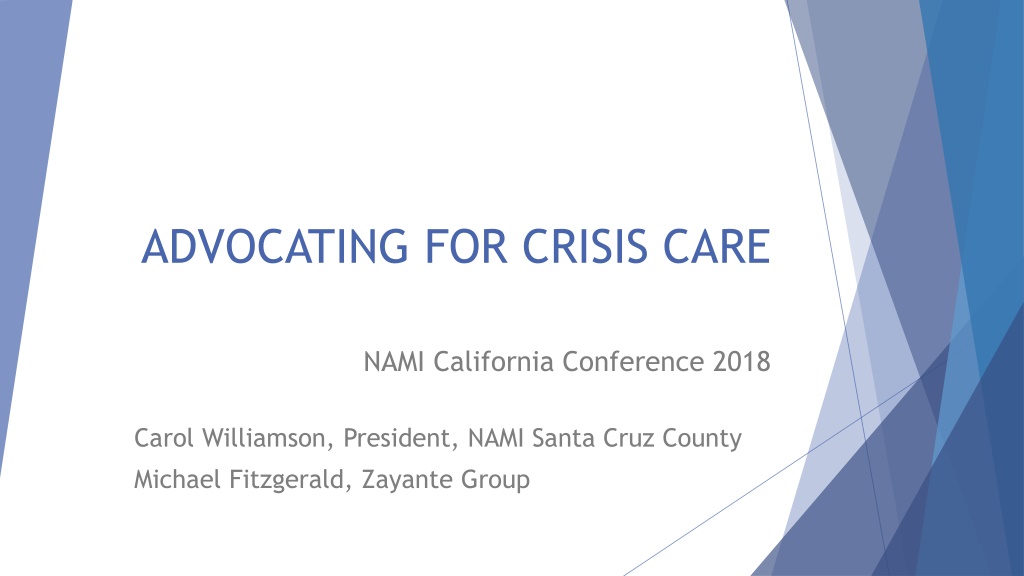
 undefined
undefined


